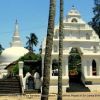කැළණිය රජ මහා විහාරය
The chronicles, Dipawansa and Mahawamsa, record in detail the story of the Buddha's visit to Kelaniya on the eighth year after his Enlightenment, on the invitation of the Naga King Maniakkhitha. The jewelled throne, on which the Buddha sat while preaching, is said to have been enshrined in the stupa at the Kelaniya temple.
The city of Kalyani, according to the chronicles, was the capital city of king Kalanakatisa, a scion of the dynasty of king Devanapiyatissa (third century BCE.) of Anuradhapura. The royal family of Magama in the south was connected to the royalty of Kalyani by the marriage of king Kavantissa of Magama to Viharadevi, the daughter of Kelanitissa. It was this matrimony that resulted in the birth of Dutugemunu (second century B.C.), considered to be the greatest of Sinhala rulers, during whose period Sri Lanka enjoyed a golden era, both politically and culturally.
Kelaniya has remained important in all historical periods, especially in the fifteenth century under the reign of Parakramabahu VI (1412-1467 A.D.) and his successors. In the years 1424 and 1475, Kelaniya was visited by Buddhist Thera’s of Cambodia, Thailand and Burma. After that it remained an important religious centre through the centuries and underwent successive developments. The present shrine dates from the first half of the nineteenth century. As recorded on the facade of the sanctum; the Sittara-style paintings are dated B.E. 2394 (1851 A.D.). The shrine has undergone further development during the first half of the twentieth century by the addition of a new and large shrine to the old one. This shrine, together with an additional room of the old shrine, has been painted entirely with a completely new style of the old idiom that remains unrivalled. The stupa of Kalyani is architecturally important in that its dome retains to this day and apparently its original form was known as ‘Dhanyaka’ (heap of paddy) shape.
The great royal monastery of Kelaniya is approached from three roads, one from the Kandy - Colombo Road near 4th mile post, another also from the Kandy Road closer to the 5th mile post and the third from Biyagama - Colombo Road, which runs along the river in front of the temple. The Vihara is located on a large earth mound facing the river. The main terrace, containing the sacred edifices, the image shrine, the historic stupa and the Bodhi tree, is approached by a steep and wide stone flight of steps at the top of which are located two beautifully constructed Toranas. Earlier, there existed only one archway, but this has been doubled in recent times. The wide lawn which leads to the main terrace contains the well-known Devale dedicated to Vibishana, the presiding deity of Kelaniya. The historic stupa which still retains its original dhanyakakara (heap of paddy) shape occupies a larger area of the terrace on the eastern sector.
The image shrine is located on the north-south axis, and the stairway has been enlarged in recent times. Original s







